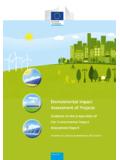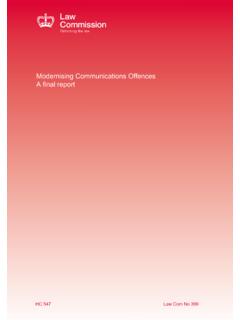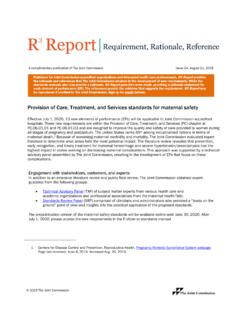Transcription of Environmental Impact Assessment of Projects
1 Environmental Impact Assessment of ProjectsGuidance on Scoping(Directive 2011/92/EU as amended by 2014/52/EU)EnvironmentPrinted in LuxembourgA great deal of additional information on the European Union is available on the can be accessed through the Europa server ( ). European Union, 2017 Reproduction is authorised provided the source is ISBN 978-79-74375-7 KH-04-17-940-EN-C PDF ISBN 978-79-74376-4 KH-04-17-940-EN-N : iStockphoto/Si-Gal iStockphoto/JuffinDisclaimer: The information and views set out in this publication are those of the author(s) and Do not necessarily reflect the official opinion of the Commission. Neither the Commission nor any person acting on the Commission s behalf may be held responsible for the use which may be made of the information contained therein.
2 The examples described in this document represent the views of the authors and are based on information gathered by the au-thors. The references used to develop these illustrative examples should always be considered as the most accurate and complete sources of information. This document benefited from Specific Contract No 070201/2016/729522/ under Framework Contract No , implemented for the European Commission by COWI A/S and Milieu main authors were: Paola Banfi, Adrien Lantieri, Jennifer McGuinn, and Alicia McNeill from Milieu Ltd. Guidance on Scoping (Directive 2011/92/EU as amended by 2014/52/EU) TABLE OF CONTENTS GLOSSARY OF TERMS .. 5 LIST OF ABBREVIATIONS .. 7 PREFACE .. 9 What is the aim of the Guidance Documents? .. 9 Who can use the Guidance Documents?
3 9 Who prepared the Guidance Documents? .. 9 How can I get a copy of the Guidance Documents? .. 9 EIA: concept and stages .. 10 GUIDANCE ON SCOPING .. 15 How to use this guidance document .. 17 PART A THE CONCEPT OF SCOPING .. 21 1 THE IMPORTANCE OF SCOPING .. 23 2 THE SCOPING PROCESS .. 24 PART B PRACTICAL GUIDANCE AND RECOMMENDATIONS ON SCOPING .. 27 1 STEP 1 INITIATION OF SCOPING .. 29 Voluntary or mandatory Scoping approaches .. 29 Scoping by the Competent Authority .. 30 Scoping by the Developer .. 31 Step 1: In a nutshell .. 31 2 STEP 2 INFORMATION NEEDED TO UNDERTAKE SCOPING .. 32 Legal requirements on information needed to undertake Scoping .. 32 Checklist on information for Scoping .. 32 Step 2: In a nutshell .. 33 3 STEP 3 SCOPING CONSULTATIONS.
4 34 Who to 35 How to consult .. 36 Essentials for effective Scoping consultation .. 38 Constraints on Scoping consultations .. 38 Step 3: In a nutshell .. 38 4 STEP 4 THE SCOPING OUTPUTS: THE SCOPING OPINION/ report .. 39 The content of the Scoping Opinion/ report .. 39 Step 4a Identifying significant effects .. 40 Step 4b Identifying Alternatives and Mitigation Measures .. 45 Step 4c Collecting 46 Step 4d Monitoring Measures .. 48 Step 4: In a nutshell .. 49 PART C SCOPING CHECKLIST .. 51 QUESTIONS ON PROJECT CHARACTERISTICS .. 53 CHARACTERISTICS OF THE PROJECT ENVIRONMENT .. 59 ANNEXES .. 63 ANNEX I LINKS WITH OTHER EU INSTRUMENTS .. 65 SEA 66 Birds and Habitats Directives .. 67 Water Framework Directive .. 68 Marine Strategy Framework Directive.
5 69 Ambient Air Quality Directive and Heavy Metals in the Ambient Air Directive .. 69 Waste Framework Directive .. 70 Industrial Emissions Directive .. 70 Seveso Directive .. 71 Trans-European Networks in transport, energy and 72 Aarhus and Espoo Conventions .. 72 ANNEX II OTHER RELEVANT GUIDANCE AND TOOLS .. 75 GLOSSARY OF TERMS Key terms used in the guidance documents are explained in the Glossary below. Term Explanation 2012 IA Study Impact Assessment Accompanying the document Proposal for a Directive of the European Parliament and the Council amending Directive 2011/92/EU on the Assessment of the effects of certain public and private Projects on the environment, SWD/2012/0355 final Alternatives Different ways of carrying out the Project in order to meet the agreed objective.
6 Alternatives can take diverse forms and may range from minor adjustments to the Project, to a complete reimagining of the Project. Baseline scenario Description of the current status of the environment in and around the area in which the Project will be located. It forms the foundation upon which the Assessment will rest. Candidate Countries Countries which are seeking to become Members States of the European Union. Competent Authority (CA) The authority which the Member States designate as responsible for performing the duties arising from the Directive. Cumulative effects Changes to the environment that are caused by an activity/project in combination with other activities/ Projects . Developer The applicant for a Development Consent on a private Project or the public authority which initiates a Project.
7 Development Consent The decision of the Competent Authority or Authorities which entitles the Developer to proceed with the Project. Effect/ Impact Any change in the physical, natural or cultural environment brought about by a development Project. EIA Directive European Union Directive 2011/92/EU, as amended by Directive 2014/52/EU on Assessment of the effects of certain public and private Projects on the environment EIA process (or EIA) The process of carrying out an Environmental Impact Assessment as required by Directive 2011/92/EU, as amended by Directive 2014/52/EU on Assessment of the effects of certain public and private Projects on the environment. The EIA process is composed of different steps: preparation of the EIA report , publicity and consultation and decision-making.
8 EIA report The Environmental Impact Assessment report is the document prepared by the Developer that presents the output of the Assessment . It contains information regarding the Project, the likely significant effect of the Project, the Baseline scenario, the proposed Alternatives, the features and Measures to mitigate adverse significant effects as well as a Non-Technical Summary and any additional information specified in Annex IV of the EIA Directive. Measures to mitigate (Mitigation Measures) Measures envisaged to avoid, prevent or reduce any identified significant adverse effects on the environment Measures to monitor (Monitoring Measures) Procedures to keep under systematic review the significant adverse effects on the environment resulting from the construction and operation of a Project, and to identify unforeseen significant adverse effects, in order to be able to undertake appropriate remedial action.
9 Member States (MS) Countries which are members of the European Union Measures to compensate / offset (Compensatory Measures) Measures envisaged to offset any identified significant adverse effects on the environment. Non-Technical Summary An easy-to-follow and understandable summary of the information included in the EIA report addressed to a non-technical audience. Project The execution of construction works or of other installations or schemes, and/or other interventions in the natural surroundings and landscape including those involving the extraction of mineral resources. Reasoned Conclusion The explanatory statement made by the Competent Authority on the significant effects of the Project on the environment, based on the examination of the EIA report and, where appropriate, on the results of its own supplementary examination.
10 Screening The process of determining whether a Project listed in Annex II of the EIA Directive is likely to have significant Environmental effects. Screening Decision Decision taken by the Competent Authority on whether a Project listed in Annex II will be made subject to the EIA procedure. Scoping The process of identifying the content and extent of the information to be submitted to the Competent Authority under the EIA process. Scoping Opinion The Competent Authority s decision on the Scoping process. LIST OF ABBREVIATIONS Key abbreviations used in the guidance documents are detailed in the list below. Abbreviation Full name AA Appropriate Assessment Aarhus Convention Convention on Access to Information, Public Participation in Decision-Making and Access to Justice in Environmental Matters CJEU Court of Justice of the European Union EIONET European Environment Information and Observation Network EMIS Environmental Marine Information System EMODNET European Marine Observation and Data Network ePRTR European Pollutant Release and Transfer Register ESPOO Convention Convention on Environmental Impact Assessment in a transboundary context GBIF Global Biodiversity Information Facility IED Industrial Emissions Directive INSPIRE Infrastructure for Spatial Information in the European Community IPCC Intergovernmental Panel on Climate Change MARS Major Accident Reporting System MSFD Marine Strategy Framework Directive PCI Project of common interest REACH















